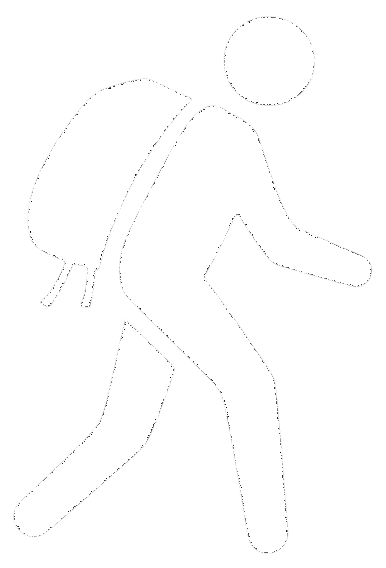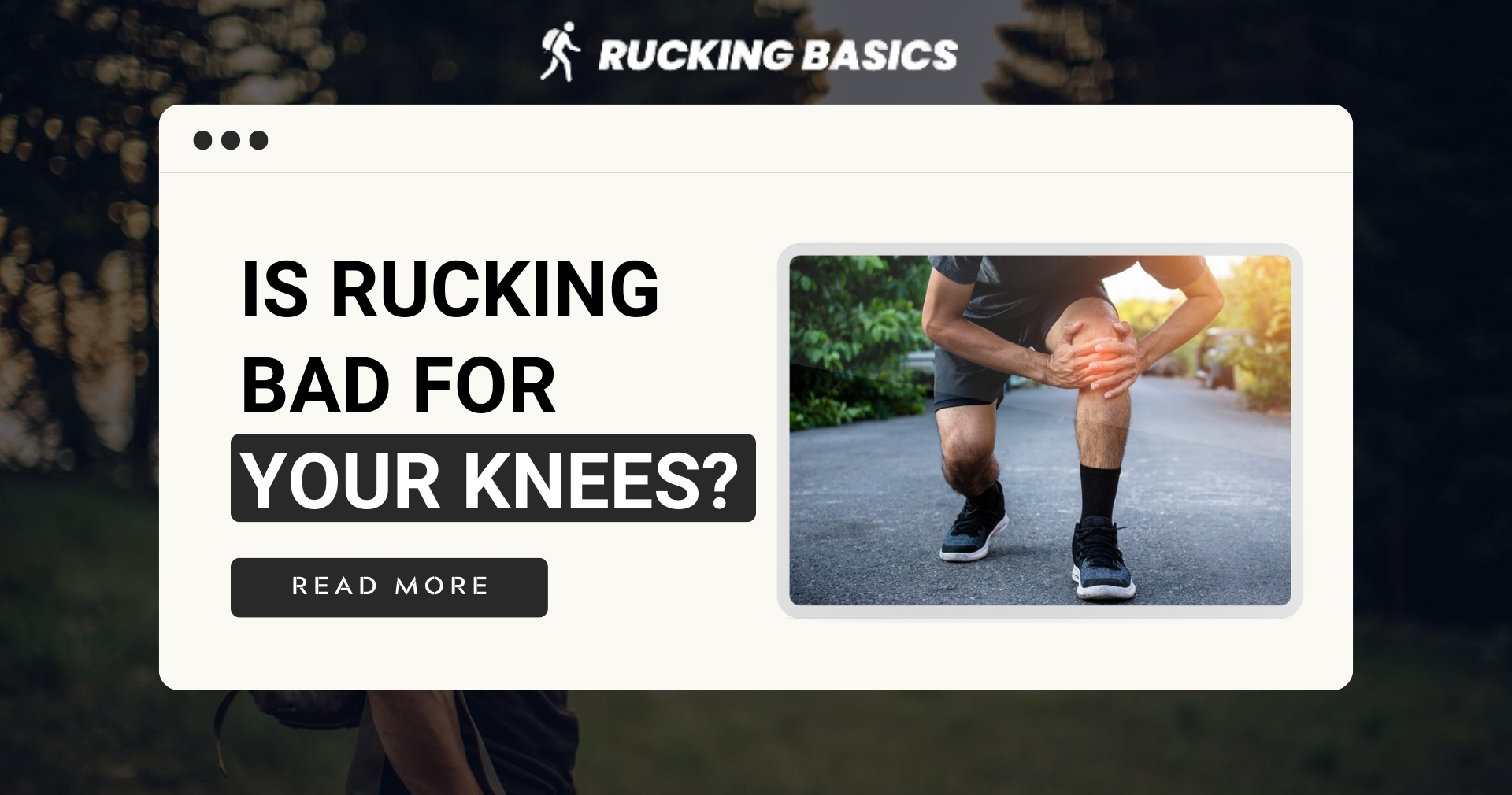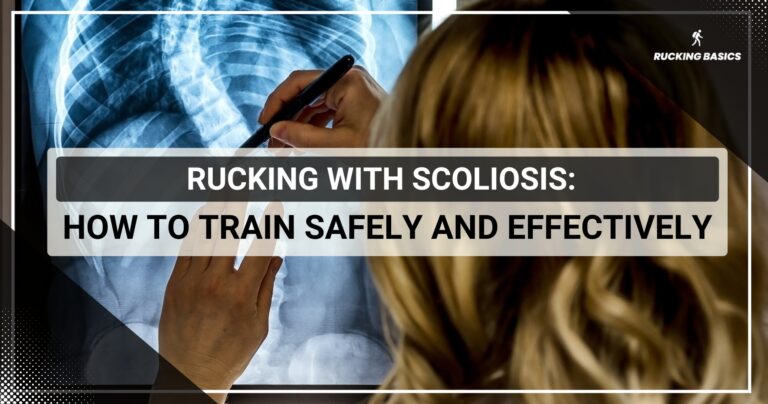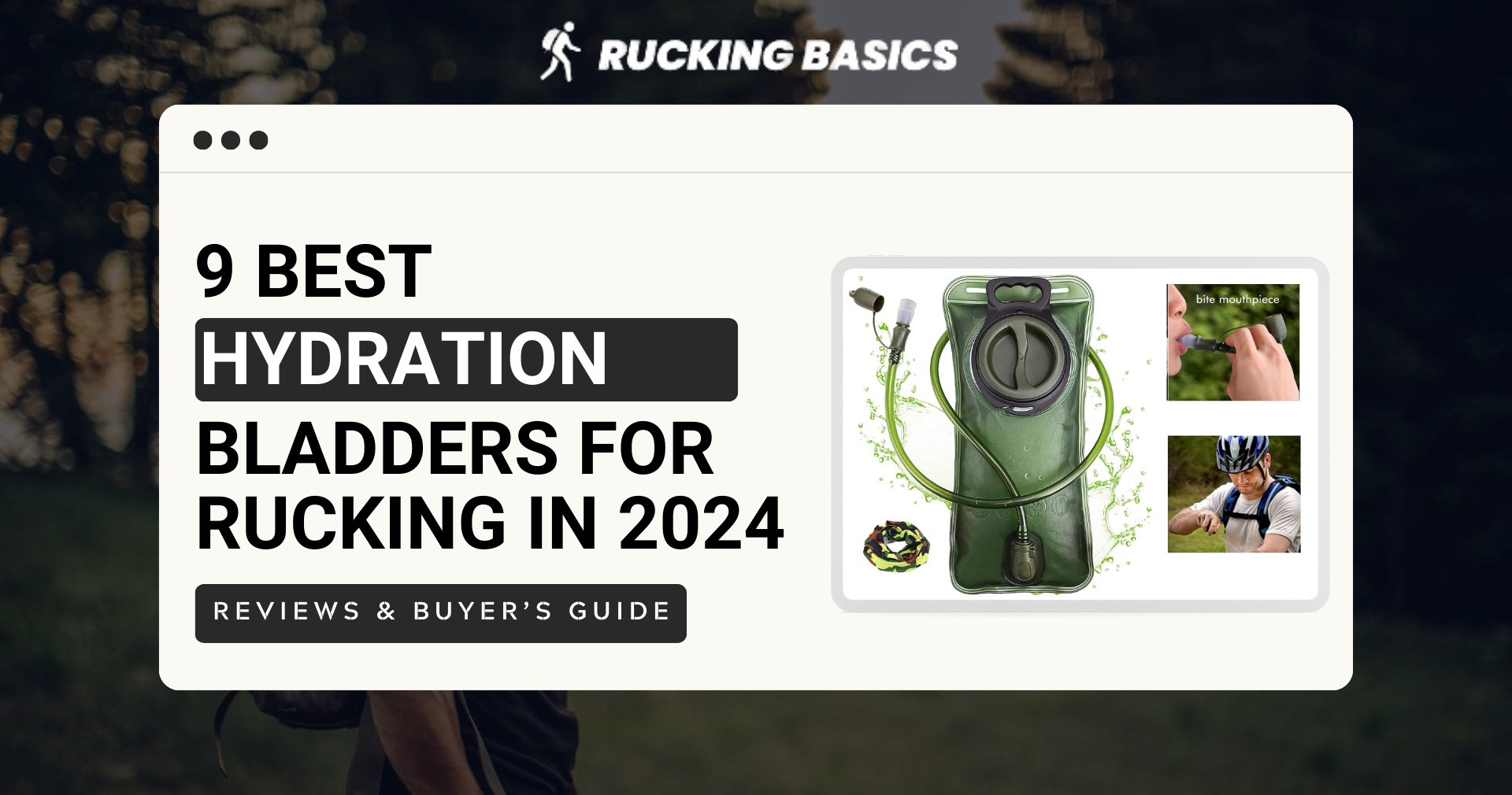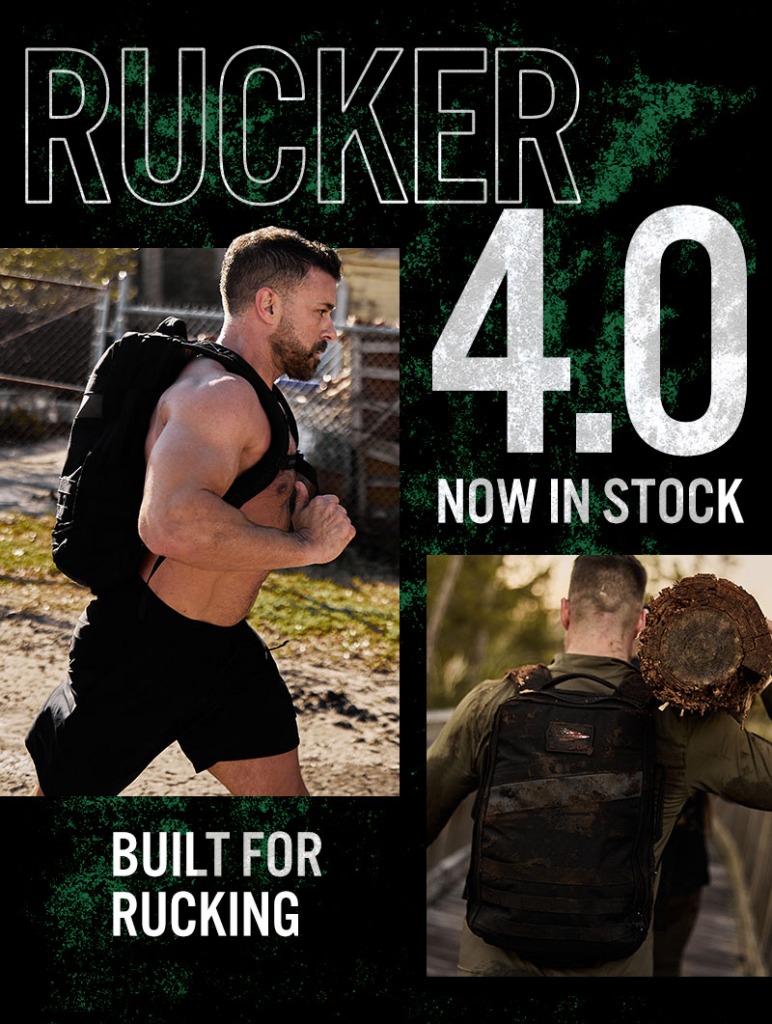Since rucking involves walking or hiking with a weighted backpack, an important question arises: is rucking bad for your knees? Given that knee pain is one of the most common problems among (active) individuals, it’s natural to wonder if rucking, with its weighted demands, could harm your knee health.
The short answer is no—rucking is not inherently bad for your knees. In fact, when done correctly, it can actually strengthen the muscles around your knees, supporting overall joint health and stability.
But like any physical activity, it carries risks if done improperly. Poor form, excessive weight, overtraining, or pre-existing knee conditions can make rucking a potential source of knee pain or even injury.
We’ll delve into the various aspects of rucking to make you aware of how rucking can both positively and negatively affect your knees, how to prevent knee injuries, and what you can do to ruck safely. Whether you’re a seasoned rucker or just starting out, this article will help you.
Is Rucking Bad for Your Knees?
Infamous knee problems…we have witnessed so many sports careers ended or significantly slowed down by knee injuries. Just think of Gabriel Batistuta, Rafael Nadal, Teddy Bridgewater, Ronaldo Nazario, and many others.
Nevertheless, knee problems (similar to back pain) are often overblown in the general population. Doctors tend to be too cautious about them, and people pay way too much attention to even the slightest pain.
Rucking, with the correct technique, weight, gear, and an awareness of your own physical capabilities, is safe for your knees. In fact, it is even quite beneficial; carrying weight strengthens the muscles and connective tissues surrounding the knee joint.
Knee Anatomy and Common Issues
The knee is one of the largest and most complex joints.
It connects the femur (thigh bone) to the tibia (shin bone) and is supported by the fibula, the patella (kneecap), and various ligaments and tendons. The primary ligaments are the anterior cruciate ligament (ACL), posterior cruciate ligament (PCL), medial collateral ligament (MCL), and lateral collateral ligament (LCL). These ligaments provide stability and control, while the tendons connect muscles to the bones.
The knee’s complex structure allows for few motions: flexion, extension (bending and straightening), and slight rotation. This flexibility is necessary for walking, running, and climbing.
Key Components of Knee Anatomy
- Cartilage: The knee contains two types of cartilage: articular cartilage and meniscal cartilage. Articular cartilage covers the ends of the femur and tibia. Meniscal cartilage, in the form of the medial and lateral meniscus, acts as a shock absorber and stabilizer, making it more prone to injuries during sports activities.
- Ligaments: The ligaments surrounding the knee joint provide stability. The ACL and PCL control the forward and backward movement of the tibia relative to the femur, while the MCL and LCL provide side-to-side stability.
- Tendons: The patellar tendon connects the kneecap to the tibia and is essential for knee extension. Other tendons, such as the quadriceps tendon, help move the knee and maintain stability.
Common knee problems include:
- Patellar Tendinitis: Often referred to as “jumper’s knee,” this condition involves inflammation of the patellar tendon.
- Osteoarthritis: A degenerative joint disease where the cartilage cushioning the knee joint gradually wears away.
- Meniscus Tears: Tears can occur due to sudden twists (especially when the leg is buried in the ground) or heavy impact.
Along those, ligament tears are also common and are considered the most serious knee injuries.
Vulnerability of the Knee During Rucking
- Weight-Bearing Stress: The knee supports the entire body’s weight. Excessive weight or sudden increases in activity places significant stress on the knee joint, potentially leading to tendonitis or arthritis.
- Repetitive Motion: Repetitive movements result in cumulative stress on the knee. Over time, this stress can contribute to wear and tear on the cartilage and other structures.
- Impact Forces: Activities that involve jumping or sudden changes in direction put high-impact forces on the knee joint.
- Lack of Muscle Support: Strong muscles around the knee, including the quadriceps, hamstrings, and calf muscles, provide support and stability. Weak or unbalanced muscles leave the knee joint more susceptible to injuries and strain.
Is Rucking Ever Harmful?
Though rucking has plenty of benefits, there are situations where it might cause harm, especially to your knees. Carrying too much weight too soon, for example, can increase the risk of injury. It’s crucial to know when rucking can be bad for your health.
Check out more details on that here: learn if rucking can be bad for your health. With the right load and proper technique, you can avoid these pitfalls and keep rucking safely.
Factors That Can Make Rucking Bad for Your Knees
So, rucking is not inherently bad for your knees; on the contrary, but some things can make it dangerous for your knees and other lower body joints.
Overloading and Knee Strain
One of the primary factors that can turn rucking into a knee-damaging activity is overloading, sometimes leading even to stress fractures. This is nothing unique to rucking — try running marathons or playing basketball on hard courts often.
Carrying too much weight while rucking increases the stress on your knees, leading to temporary and later chronic knee problems. The same is with obesity and why weight loss is advised for knee pain. Additionally, overloading can also help build rucking calves, which are crucial for balancing and absorbing the additional load.
For shoe support, the GORUCK MACV-2 review provides insights into their ankle support and shock absorption, which can reduce stress on your knees during heavy rucking sessions.
The key is to start with appropriate weight and not ruck too often. Overloading your pack too soon is terrible for your joints since your body is not yet accustomed to bearing such a load.
Pro Tip: Read this GORUCK Mackall shoes review to check if they offer adequate support for your knees during heavy rucking sessions. They might just be the thing you were looking for.
Improper Form and Technique
I often see many technique mistakes on ruck marches, even with experienced truckers. Leaning too far forward, locking the knees while walking, or taking overly long strides place unnecessary pressure on the knees.
Good rucking form involves:
- Keeping your back straight and shoulders relaxed.
- Engaging your core to support the load.
- Taking short, controlled steps.
- Slightly bend your knees with each step to absorb impact.
Pre-existing Conditions
If you have pre-existing knee conditions, such as arthritis, previous injuries, or chronic pain, the added weight and walking will certainly not be curative. This does not mean that you must not ruck, but you must be very careful with the load on an already compromised joint.
Your orthopedist or other specialist can give you the necessary advice based on your individual problem.
How to Prevent Knee Problems While Rucking?
Of course, suitable weight and frequency are the most important, but also pay attention to:
Warm-Up and Stretching
Prepare your knees and the surrounding muscles for the physical activity ahead. A proper warm-up increases blood flow to the muscles, making them more flexible and less prone to injury.
Focus on dynamic stretches, not passive ones.
Strengthening the Knee-Supporting Muscles
Leg muscle strength is paramount, not only for rucking but in general.
Key exercises in your strength training plan are:
- Squats: Target the quadriceps, hamstrings, and glutes, all of which support knee stability.
- Leg Curls: Focus on strengthening the hamstrings, which are crucial for knee support.
- Step-Ups: Mimic the motion of rucking and help build the strength needed for uphill or uneven terrain.
Investing in Quality Footwear
The right pair of shoes provides the necessary support and cushioning to absorb the impact that would otherwise be transferred to your knees.
If you’re looking for a lower-impact option or want to ruck indoors, you might consider rucking on a treadmill. This can reduce strain on your knees while still providing the benefits of rucking, especially if you’re recovering from knee discomfort or just starting out.
Look for shoes designed for rucking with good arch support, a cushioned sole, and a snug fit. Consider using insoles as well.
Post-Ruck Recovery
Like the rest of your body, your knees need time to recover after a rucking session. A post-ruck recovery routine can help alleviate knee strain and prevent injuries.
This routine should include:
- Stretching: It’s not mandatory, but it reduces stiffness.
- Foam Rolling: I really like to use a foam roller to release muscle tension and improve blood flow.
- Rest: The main thing according to sports medicine experts — rest. Give your knees time to recover by taking rest days between rucking sessions, especially if you experience any discomfort.
What to Do If You Feel Knee Pain While Rucking?
Early recognition of warning signs is crucial to preventing more serious injuries. Warning signs include:
- Persistent pain during or after rucking.
- Swelling around the knee joint.
- A feeling of instability or weakness in the knee.
If you experience any of these symptoms, take them seriously and take action immediately. You can try ice and nonsteroidal anti-inflammatory drugs (NSAIDs) for a short time (if you are healthy), but that is only a temporary solution.
The key is to determine the underlying cause, and if you can’t do that alone while the pain persists or worsens, seek medical advice.
Conclusion
To protect your knees and maximize the benefits of rucking, you must be aware of factors that can lead to knee strain. Choosing the appropriate load, focusing on proper form, and strengthening the muscles around your knees are steps to significantly reduce the risk of injury or even reduce persistent pain. We have another tip for you — buy ruck sack (or weighted vest) and ruck plate to improve balance.
If you still experience knee pain while rucking, recognize the warning signs early and take immediate action to prevent further damage. Consider modifying your rucking routine or exploring low-impact alternatives for some time if that’s what your doctor or coach recommends. But don’t stick to low-impact activities for too long because you will lose the adaptations that rucking caused.
You can enjoy rucking for years to come if you treat your knees with care. They’ll carry you through countless miles of rucking adventures.
Frequently Asked Questions (FAQ)
How often should I rest my knees between rucking sessions to prevent overuse injuries?
You should take at least one to two rest days between intense rucking sessions. This gives your knees time to recover and reduces the risk of overuse injury.
Can wearing a knee brace help prevent knee injuries while rucking?
A knee brace can provide extra support and stability, especially if you have a history of knee issues. However, wearing knee braces (or any other) for a long time is counterproductive because the muscles weaken, and your body starts to rely exclusively on the braces.
How does rucking compare to running in terms of knee impact?
Rucking generally impacts the knees less than running because the pace is slower, and the load is evenly distributed. Yet, the added weight in rucking can strain the knees if not managed properly.
Is it safe to ruck with mild knee pain, or should I stop immediately?
If you experience mild knee pain, it’s best to stop rucking and assess the situation. Continuing could worsen the pain or increase injury risk, so it’s important to address the issue early.
Are there any supplements that can support knee health for ruckers?
Glucosamine, chondroitin, and omega-3 fatty acids support joint health, including the knees. Before starting any supplement regime, talk to your doctor.
References
Kraus VB, Sprow K, Powell KE, Buchner D, Bloodgood B, Piercy K, George SM, Kraus WE; 2018 PHYSICAL ACTIVITY GUIDELINES ADVISORY COMMITTEE*. Effects of Physical Activity in Knee and Hip Osteoarthritis: A Systematic Umbrella Review. Med Sci Sports Exerc. 2019 Jun;51(6):1324-1339. doi: 10.1249/MSS.0000000000001944. PMID: 31095089; PMCID: PMC6527143.
Yang L, Wang P, McGill B. The relationship between experience of knee pain and physical activity participation: A scoping review of quantitative studies. Int J Nurs Sci. 2023 Mar 21;10(2):258-267. doi: 10.1016/j.ijnss.2023.03.010. PMID: 37128486; PMCID: PMC10148261.
Driban JB, Hootman JM, Sitler MR, Harris KP, Cattano NM. Is Participation in Certain Sports Associated With Knee Osteoarthritis? A Systematic Review. J Athl Train. 2017 Jun 2;52(6):497-506. doi: 10.4085/1062-6050-50.2.08. Epub 2015 Jan 9. PMID: 25574790; PMCID: PMC5488840.
